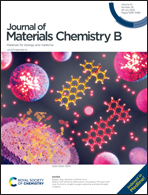Vascularized nanocomposite hydrogel mechanically reinforced by polyelectrolyte-modified nanoparticles†
Abstract
Vascularization plays an important role in the initial stage of triggering bone defect repair. The combination of bioactive small molecule drugs and biomaterials has been a powerful strategy for vascularization in bone tissue engineering. In this study, an in situ crosslinked aldehyde hyaluronic acid (AHA)/N,O-carboxymethyl chitosan (NOCC) nanocomposite hydrogel doped with sphingosine 1-phosphate (S1P)-loaded polyelectrolyte-modified mesoporous silica nanoparticles (MSNs) was developed. The alginate/chitosan polyelectrolyte-modified MSNs (MSNs–ALG/CHI) were prepared via the electrostatic interaction. The incorporation of MSNs–ALG/CHI not only achieved a sustained release profile of the angiogenic drug, but also improved the mechanical property of the AHA/NOCC hydrogel due to the Schiff base reaction between the amino group in chitosan and the aldehyde group in AHA. In addition, in vitro cell experiments demonstrated that the nanocomposite hydrogel provided favorable support for cell adhesion and proliferation, and the S1P-loaded nanocomposite hydrogel was able to recruit endothelial cells. More importantly, the chicken chorioallantoic membrane (CAM) assay confirmed that the S1P-loaded nanocomposite hydrogel could significantly enhance capillary formation. More cell infiltration and better angiogenesis in the S1P loaded nanocomposite hydrogel were observed compared to the group without S1P loading after being implanted subcutaneously for 2 weeks. Furthermore, the subcutaneous implantation experiment further demonstrated that the incorporation of the S1P-loaded nanocomposite hydrogel could improve the tissue infiltration and new vessel formation within the macroporous poly(L-lactic acid)/polycaprolactone scaffold. Our results suggest that the nanocomposite hydrogel will be an excellent drug delivery system and the S1P-loaded nanocomposite hydrogel has great potential for vascularized bone regeneration application.



 Please wait while we load your content...
Please wait while we load your content...